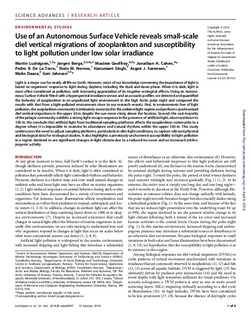| dc.contributor.author | Ludvigsen, Martin | |
| dc.contributor.author | Berge, Jørgen | |
| dc.contributor.author | Geoffroy, Maxime | |
| dc.contributor.author | Cohen, Jonathan H. | |
| dc.contributor.author | De La Torre, Pedro R. | |
| dc.contributor.author | Nornes, Stein Melvær | |
| dc.contributor.author | Singh, Hanumant | |
| dc.contributor.author | Sørensen, Asgeir Johan | |
| dc.contributor.author | Daase, Malin | |
| dc.contributor.author | Johnsen, Geir | |
| dc.date.accessioned | 2018-04-10T06:25:22Z | |
| dc.date.available | 2018-04-10T06:25:22Z | |
| dc.date.created | 2018-02-03T10:06:07Z | |
| dc.date.issued | 2018 | |
| dc.identifier.citation | Science Advances. 2018, 4 1-8. | nb_NO |
| dc.identifier.issn | 2375-2548 | |
| dc.identifier.uri | http://hdl.handle.net/11250/2493296 | |
| dc.description.abstract | Light is a major cue for nearly all life on Earth. However, most of our knowledge concerning the importance of light is based on organisms’ response to light during daytime, including the dusk and dawn phase. When it is dark, light is most often considered as pollution, with increasing appreciation of its negative ecological effects. Using an Autonomous Surface Vehicle fitted with a hyperspectral irradiance sensor and an acoustic profiler, we detected and quantified the behavior of zooplankton in an unpolluted light environment in the high Arctic polar night and compared the results with that from a light-polluted environment close to our research vessels. First, in environments free of light pollution, the zooplankton community is intimately connected to the ambient light regime and performs synchronized diel vertical migrations in the upper 30 m despite the sun never rising above the horizon. Second, the vast majority of the pelagic community exhibits a strong light-escape response in the presence of artificial light, observed down to 100 m. We conclude that artificial light from traditional sampling platforms affects the zooplankton community to a degree where it is impossible to examine its abundance and natural rhythms within the upper 100 m. This study underscores the need to adjust sampling platforms, particularly in dim-light conditions, to capture relevant physical and biological data for ecological studies. It also highlights a previously unchartered susceptibility to light pollution in a region destined to see significant changes in light climate due to a reduced ice cover and an increased anthropogenic activity. | nb_NO |
| dc.language.iso | eng | nb_NO |
| dc.publisher | American Association for the Advancement of Science | nb_NO |
| dc.rights | Navngivelse-Ikkekommersiell 4.0 Internasjonal | * |
| dc.rights.uri | http://creativecommons.org/licenses/by-nc/4.0/deed.no | * |
| dc.title | Use of an Autonomous Surface Vehicle reveals small-scale diel vertical migrations of zooplankton and susceptibility to light pollution under low solar irradiance | nb_NO |
| dc.type | Journal article | nb_NO |
| dc.type | Peer reviewed | nb_NO |
| dc.description.version | publishedVersion | nb_NO |
| dc.source.pagenumber | 1-8 | nb_NO |
| dc.source.volume | 4 | nb_NO |
| dc.source.journal | Science Advances | nb_NO |
| dc.identifier.doi | 10.1126/sciadv.aap9887 | |
| dc.identifier.cristin | 1561451 | |
| dc.relation.project | Norges forskningsråd: 244319 | nb_NO |
| dc.relation.project | Norges forskningsråd: 223254 | nb_NO |
| dc.description.localcode | Copyright © 2018 The Authors, some rights reserved; exclusive licensee American Association for the Advancement of Science. No claim to original U.S. Government Works. Distributed under a Creative Commons Attribution NonCommercial License 4.0 (CC BY-NC). | nb_NO |
| cristin.unitcode | 194,64,20,0 | |
| cristin.unitcode | 194,66,10,0 | |
| cristin.unitname | Institutt for marin teknikk | |
| cristin.unitname | Institutt for biologi | |
| cristin.ispublished | true | |
| cristin.fulltext | original | |
| cristin.qualitycode | 1 | |

